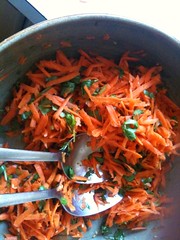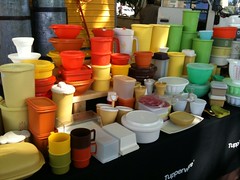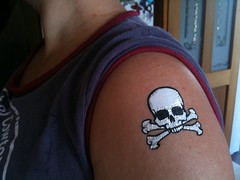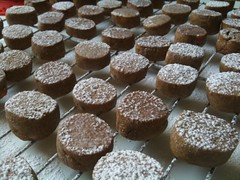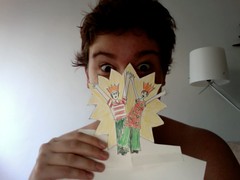I want to add something to my first post discussing the CSIRO diet.
Here is some very basic information I’ve found in the two CSIRO books. I haven’t looked further afield (yet).
The acknowledgments in the second book write:
CSIRO gratefully acknowledges all those who have contributed to the funding of research on higher-protein diets for weight management: CSIRO Human Nutrition; Dairy Australia; Goodman Fielder; Meat and Livestock Australia; The National Heart Foundation; The National Centre for Excellence for Functional Foods; The National Health and Medical Research Council
My immediate response to this funding from particular interest groups (especially Meat and Livestock Australia) is to wonder just how trustworthy the findings of this research can be. But then I think about the realities of funding for research in Australia. It is probably not so much that the funding bodies dictated the terms of the research, but that there wasn’t funding available for research into alternatives to a high-meat diet. I’m reasonably confident that CSIRO (and the authors of this book) are reputable researchers. So it’s not as though we’re reading a diet book written by me.
This of course raises all sorts of interesting questions about the role of public bodies – government research bodies – as ‘reputable’ or authoritative sources of knowledge and information. It also makes me wonder about the way we are willing to accept ‘scientific’ research about health and bodies as ‘objective’ and ‘reputable’, but are far more sceptical of research on these topics from the humanities. I have read some really, seriously dodgy published work in the humanities on bodies and diet and food and so on – stuff that’s really theoretical supposing and not at all substantiated by solid data – but I’ve also read some equally dodgy ‘scientific’ work. I think, though we could probably accept that CSIRO is quite good at doing ‘scientific’ research, that it would be wrong to assume that this study (as with any ‘scientific’ study) is objective or neutral or reporting ‘just the facts’. This study is as guided by ideology and notions of ‘body’ and ‘health’ as any other. Science isn’t neutral; it’s just institutionalised in a different way.
At any rate, I approach the CSIRO diet with a degree of critical engagement. I want to ‘trust’ this study and diet, but at the same time, this is my body and I don’t want to fuck it up with the consequences of bullshit research.
With this in mind, here are a few issues that I have with the CSIRO diet’s approach to food, and most importantly with its recipes. Firstly, it’s worth pointing out that the books have three general sections:
1. a discussion of the research into health and nutrition upon which the ‘diet’ is based;
2. a section outlining exercise, and providing some basic exercises;
3. a section of menu plans and recipes.
The books do not position the diet (and its approach to food and nutrition) within political, social, cultural context. There is no discussion about the political economies of food. There’s no talk about the social and environmental sustainability of particular diets and lifestyles. There’s no discussion about (or even reference to) class and how spending money on food is not dictated entirely by ‘lifestyle choices’, but my the basic economics of living within a budget. I do quite like the way it avoids discussions about body image and gendered notions of ‘beauty’, instead emphasising the benefits of fitness and good health: feeling good. I could also discuss the pictures (which are quite heterocentric and feature far more women than men), and I might later in another post.
Generally, the books remind me of the ABC. Sort of middle class aesthetics, careful with its gender talk (but still gendered), articulate but not alienating in its language, lots of nice san serif fonts. It appears ‘neutral’, but of course it’s not.
The one issue I want to take up here is the books’ approach to (or neglect of) vegetarianism and veganism.
I wrote this in my previous post:
There are also questions to be asked about the CSIRO diet’s funding (which was in part from Australian primary producers – meat farmers to be specific) and how this affected their research and findings. Their very brief section(s) on vegetarianism are really quite bullshitty. There’s a line something like ‘there’s no evidence that vegetariaism is bad for you…’ Which of course is misleading if not downright deceitful. A vegetarian diet is much better for you than a meat diet, so long as you’re eating well. No diet is good for you if it doesn’t have mostly fresh fruit and vegies, wholegrain foods, dairy products and then protein, and finally a small amount of certain types of fats. You can skip the dairy stuff (so long as you replace it), but you certainly don’t need to eat meat.
But I wasn’t entirely accurate. I was actually a bit full of shit, there. Here’s what the CSIRO books actually say:
The first book has this to say about vegetarianism:
Our bodies have evolved to thrive on a wide variety of both animal and plant foods. Many people eat a plant-based diet by way of necessity, but others choose to for a wide range of reasons. Population studies have shown that vegetarians have a lower risk of obesity, coronary heart disease, high blood pressure, type 2 diabetes and some forms of cancer – but it is not clear if this is due to their diet or their lifestyle. However, if you are a vegetarian, you need to plan your diet carefully to make sure that all essential nutrients are included (p 39-40 Book 1)
And this (within a very serious section about the importance of calcium, particularly for women:
Vegetarians absorb and retain more calcium than do non-vegetarians. Vegetable greens such as spinach and broccoli, and some legumes and soybean proucts are good sources of calcium. Vegetarians who eat dairy foods will obtain sufficient calcium (p 46 book 1).
There’s even less about vegetarianism in the second book (in a section addressing readers’ questions):
Is there a diet for vegetarians?
We have not investigated whether a high-protein vegetarian diet is as effective as a high-animal-protein diet, but we do know that vegetable protein confers a similar benefit in reducing hunger. You may want to consult your GP or dietician to modify the Diet for your needs. If you wish to substitute non-meat protein, we would suggest eating 200g tofu or 260g cooked chickpeas, beans or lentils instead of 200g meat, fish or chicken (p33 book 2).
The context of these quotes – sections ‘warning’ about the dangers of inadequate amounts of calcium (for women especially), about malnutrition generally – is significant. Vegetarianism is framed in terms of nutritional failure or of malnutrition. It is pathologised. This is the most common criticism I’ve heard of vegetarianism: that you have to eat really carefully or else you won’t get the nutrients you need, and that this is very difficult (if not impossible). My immediate response is to wonder whether most omnivorous human beings in mainstream Australian society eat ‘properly’. Eating meat does not automatically ensure proper nutrition. The meat is far less important than the other stuff you should be eating. A standard ‘meat and three veg’ diet with its emphasis on white bread, processed foods and meat rather than vegetables and fruit is not as nutritionally balanced as it might appear. There’s lots of interesting stuff written about the way this type of diet developed in Australian culture, with attendant discussions of mid- and post-war shortages, the rise of supermarkets, gendered division of labour in the home, the economics of mass-production and distribution of food and so on.
Perhaps the most interesting part of this literature (with which I am not terribly familiar) is the idea that science (and the idea of ‘Science’) defined or shaped ‘modern’ living and food. We could go on here about a movement away from diversity in food plant stocks and towards the genetic ‘management’ of food my corporations. We could also talk about the way diets are shaped by supermarket wholesale purchasing and relationships with growers. And we could discuss the role of class in ‘whole food’ or ‘organic’ counter-movements. But I don’t really have the brain for it today. Really, what I want to say here is that the ‘meat and three veg’ diet is culturally specific. It’s shaped by class and gender and ethnicity and so on. It’s not ‘natural’ and it didn’t ‘just happen’. It is a product of economics and capitalism, of patriarchy, of mass media discourse and so on. It’s also, ironically, the product of government policy and ‘education’.
So, what I really should have just said above, is that vegetarianism is presented as deviance from a ‘normal’, ‘healthy’ diet in the CSIRO diet, and that this reflects broader mainstream notions of vegetarianism. But, of course, it’s not. Vegetarianism is as difficult/easy as omnivorous eating. It is, however, more difficult socially and culturally in many contexts. Dining out offers the best example of this: vegetarian restaurants are fewer in number than omnivorous ones in Australia, and vegetarian dishes are marginalised within mainstream menus at Australian restaurants.
A prioritising of meat of course makes sense in the CSIRO diet: this is a diet focussing on high-protein diets. More specifically, it is concerned with the importance of meat in a high-protein diet. I think that the issue not so much the neglect of vegetarianism, but the over-emphasis of meat and neglect of non-meat protein sources.
What this means, in terms of the menu plans and recipes, is that the dishes are all constructed around meat. The meals are still thinking of the ‘meat and three veg’ ratio, rather than thinking of meals as a combination of elements. This basic point is one that we find most difficult about the CSIRO recipes. Each meal is constructed as one item + one item + one item. This is almost diametrically opposite to the notion of constructing a meal as a complex, harmony of flavours and elements. As an alternative, we might construct a meal that is composed of a series of small dishes, each representing one of a series of flavours: salty, sweet, wet, dry, etc. Or we might select ingredients that balance the ‘humours’ of the body: cooling, heating, etc. The meat and three veg diet lumps vegetables into one or two groups: greens and ‘others’. We might instead think of the role of brassicas and leafy green vegetables in relation to pulses and grains and root vegetables. Though the CSIRO diet does explore the sources of particular minerals and nutrients, the meals themselves are still imagined as ‘meat and…’:
Tandoori chicken with garlic spinach
chicken with djon mustard and white wine
chicken and tarragon meatloaf
(book 1 recipe titles)
And vegetable dishes are then served with them (if at all).
In practical terms, this means that you buy the meat first, then look for vegetables to go with it. This tends to suggest that cooks will look first to their meat, then their vegetables. Which means that they’re more likely to use fresh meat and less likely to use fresh vegetables. If meat is the priority, then the veggies are the ‘add-on’ rather than the central taste and ideological ingredient. Financially, it’s challenging to build a menu around meat – it’s one of the most expensive ingredients. But then the CSIRO diet is not cheap. In part because of its emphasis on meat, but also because of its neglect of seasonal variations in ingredients. I think it’s worth emphasising the importance of cost: this is not a diet for those on a low budget.
Of course, this leads me to an interesting point: the idea of meat as a luxury good. This line from the CSIRO book works with this point:
Many people eat a plant-based diet by way of necessity, but others choose to for a wide range of reasons.
The line about necessity is key. I wish they’d expanded. What issues do they feel necessitate vegetarianism? Poverty? Religious restrictions? Geographic location? Allergies? I also wish they’d referenced some of the reasons vegetarianism is chosen. A few million spring to my mind immediately: ethical (preventing cruelty to animals, treading lightly environmentally, avoiding unjust labour and economic practices…), religious, economic… Surely vegetarianism for these ‘reasons’ is a necessity. It is necessary that they choose not to exploit animals. It is necessary that they live simply so that others may simply live. It is necessary that they honour the teachings of a holy figure by not taking lives.
Finally, the point I’d like to return to at the end, is the one of eating seasonally. The CSIRO diet does not in any way account for seasonal variation in fresh produce. It relies upon its users shopping at conventional supermarkets and having access to all ingredients at any time. We found that the preponderance of particular ingredients (tarragon!) made shopping expensive. The neglect not only of seasonal variation, but also of regional availability made shopping difficult and expensive. This is where we first began varying the menu plans: we didn’t want to eat manky out-of-season tomatoes, or to walk past gorgeous fresh asparagus.
One of the delights of a vegetarian diet is that you supplement dried ingredients (grains, pulses) with fresh produce. Your diet changes with the seasons. In practical terms, this means that you’re eating a menu that changes over the year; you don’t just keep eating the same old stuff, day in and day out, regardless of its freshness or availability. Seasonal produce – stuff that’s in season is fresher, tastes and looks better and is cheaper than stuff that is not. So it simply makes sense to build meals around ingredients which are in season rather than force-grown in a greenhouse, shipped in from overseas and riddled with preservatives and generally sapped of any flavour.
Eating seasonally does require some knowledge of the seasons, and also, by extension, of local farming practices. But this sort of knowledge can come almost osmotically if you’re not shopping in a supermarket. Supermarkets stock the same products, day in, month out. Greengrocers and fresh food markets tend to buy most what is cheapest as well as keeping in stock perennial favourites. But when you’re shopping at a greengrocer every week, you see the biggest piles of cheapest vegetables change with the seasons. Even if you’re not buying organic.
Of course, buying organic is something the CSIRO diet does not make simple. Meat-centred meals with un-seasonal menus do not support a diet of organic, seasonal produce. While the second does not refer to it at all, the first book has this to say about organic produce:
We are often asked whether or not it’s better to buy organic produce. Although organic fruit and vegetables are probably no more nutritious than conventionally grown varieties, they may taste better. Some organic leafy vegetables and potatoes also seem to have higher vitamin C contents, which may be due to the fact that organic produce is often smaller and therefore denser than conventional produce, which has a high water content. The bottom line is that eating more fruit and vegetables, whether organic, conventional, fresh, frozen or tinned, will increase your intake of protective compounds and is important for good health (p50)
There’s a whole world of wrong in that paragraph. I’ll let other people explain why.
I know I’ve rambled off-topic a bit here. I began with an argument about the CSIRO diet’s anti-vegetarian stance. But I think it’s important to point out how a meat-centred diet which neglects seasonal variation discourages the consumption of organic produce and encourages the consumption of processed foods (including canned and frozen food). I think that eating out of season is a matter of swimming upstream when you’re trying to convince people to eat more fruit and vegetables. If the fruit and vegies they’re eating don’t taste too good (because it’s out of season, loaded with preservatives and pesticides or simply sat around for too long), people won’t eat them. If the fruit and vegies they have do taste delicious, they will eat them.
I think this is at the heart of a ‘healthy’ diet. Eating well should be a delight to the senses. It should be about pleasure. This means that a ‘good diet’ not only avoids discussions of ‘restriction’, ‘denial’, ‘guilt’ and ‘suppression of appetite’, but actively encourages pleasure and interest in food. Healthy eating is about enjoying food, about taking an interest in the growing and preparation of produce. It is about the provocation of appetite, the association of food with pleasure and happiness.
It’s no wonder that hardcore cooks become interested in . An interest in cooking leads to an interest in sourcing produce. And this leads to producing your own food – even if only your herbs. For many foodies, an interest in gardening leads naturally to an interest in water and sustainable food production. But not all foodies. I think it’s worth pointing out that being interested in food and growing your own veggies does not necessarily mean you’ll end up a hardcore hippy growing organically. I think it’s also worth pointing out that availability (or lack of it) often pushes cooks to gardening. I’m thinking about migrants in particular: tomatoes in Brunswick, bok choy in Ashfield. Frugality is often a prime motivator for gardening: it’s far cheaper to grow your own organic produce from seed than buy it from the shops.
While the CSIRO diet has been very useful, I think that its neglect of these sorts of social, cultural, economic and scientific issues is a profound weakness.
Having said that, though, I think that its success is largely owed to the fact that it does not address these issues. Perhaps, then, it’s worth thinking about the CSIRO diet as a gateway drug, encouraging an interest and food and cooking and nutrition that might lead to experimentation with other recipes and food types? Unfortunately, I think that the CSIRO diet’s books discourage this type of exploration. Though the book suggests that once the ‘initial’ ‘weight loss’ part of the diet is achieved, users should move on to tailoring their meals to suit their (new) lifestyles, I wonder just how many users do stay with the diet long enough to reach that point.
Ultimately, the CSIRO diet is not so much a ‘diet’ as a manual for lifestyle change. But it is not, unfortunately, a manual for ideological change in terms of approaches to socially and environmentally sustainable food production and preparation.


